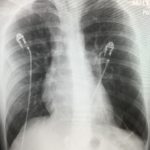Bullous Emphysema
History of present illness:
27-year-old male presented with left chest pain and shortness of breath for 1 month. He reported sharp pain and urge to cough upon taking a deep breath. His lungs were clear bilaterally, without rhonchi, wheezing, rubs or crackles. He denied fevers and never smoked. He had an albuterol inhaler as needed for allergic wheezing.
Significant findings:
The upright chest X-ray shows a large lucent area in the left lower lung field without lung markings, with associated curvilinear opacities (yellow arrows) consistent with a large air-filled bulla. The bulla is large enough to compress adjacent lung tissue as shown by the visible pleural line (blue line). The discontinuity of the pleural line and presence of lung markings superiorly makes these findings more consistent with bulla than pneumothorax. The chest computed tomography (CT) confirmed a large left hemithorax bulla.
Discussion:
A bulla is a greater than 1 cm distended space of air in the lung.1 If the space occupies greater than 30% of the hemithorax, it is considered a giant bulla.2 The most common causes of bulla formation are smoking, chronic obstructive pulmonary disease (COPD)or idiopathic.1 Damage to the alveoli causing distension may result in the formation of larger air spaces, known as a bulla. Giant bulla are rare occurrences; thus, the epidemiology is not well characterized.3 Patients can present asymptomatically or with obstructive pulmonary symptoms such as productive cough and dyspnea. Chest X-ray is generally sufficient to diagnose a bulla, but may be mistaken as a pneumothorax, which can lead to incorrectly placing a chest tube.3
However, this is not always true, as seen in the chest X-ray above. Mediastinal structures can be deviated to the contralateral side in both a bulla or pneumothorax.4 Thus, any questionable bulla should be confirmed with a chest CT. While comparisons of imaging modalities specifically for giant bullous disease has not been well documented, there is evidence that CT is more sensitive than chest X-ray in detecting emphysematous pulmonary disease.5
For symptomatic patients, treatment of giant bulla is initially managed medically. Surgical bullectomy is considered in refractory and symptomatic idiopathic cases.6 Our patient was treated in the emergency department with ipratropium and albuterol. With treatment, his oxygen saturation improved to greater than 95% on room air. The bulla was discussed with pulmonology, who agreed this could be treated as an outpatient. The patient was discharged home with pulmonology follow-up.
Topics:
Bullous emphysema, chest radiograph, pneumothorax, bulla.
References:
- Thurlbeck WM. Pathophysiology of chronic obstructive pulmonary disease. Clin Chest Med. 1990;11(3):389-403.
- Neviere R, Catto M, Bautin N, et al. Longitudinal changes in hyperinflation parameters and exercise capacity after giant bullous emphysema surgery. J Thorac Cardiovasc Surg. 2006;132(5):1203-1207.doi: 10.1016/j.jtcvs.2006.08.002
- Bourgouin P, Cousineau G, Lemire P, Hébert G. Computed tomography used to exclude pneumothorax in bullous lung disease. J Can Assoc Radiol. 1985;36(4):341-342.
- Chen CK, Cheng HK, Chang WH, Lai YC, Su YJ. Giant emphysematous bulla mimicking tension pneumothorax. Am J Med Sci. 2009;337(3):205.doi: 10.1097/MAJ.0b013e31818713f0
- Uppaluri R, Mitsa T, Sonka M, Hoffman EA, McLennan G. Quantification of pulmonary emphysema from lung computed tomography images. Am J Respir Crit Care Med. 1997;156(1):248-254.
- Palla A, Desideri M, Rossi G, et al. Elective surgery for giant bullous emphysema: a 5-year clinical and functional follow-up. 2005;128(4):2043-2050. doi: 10.1378/chest.128.4.2043





